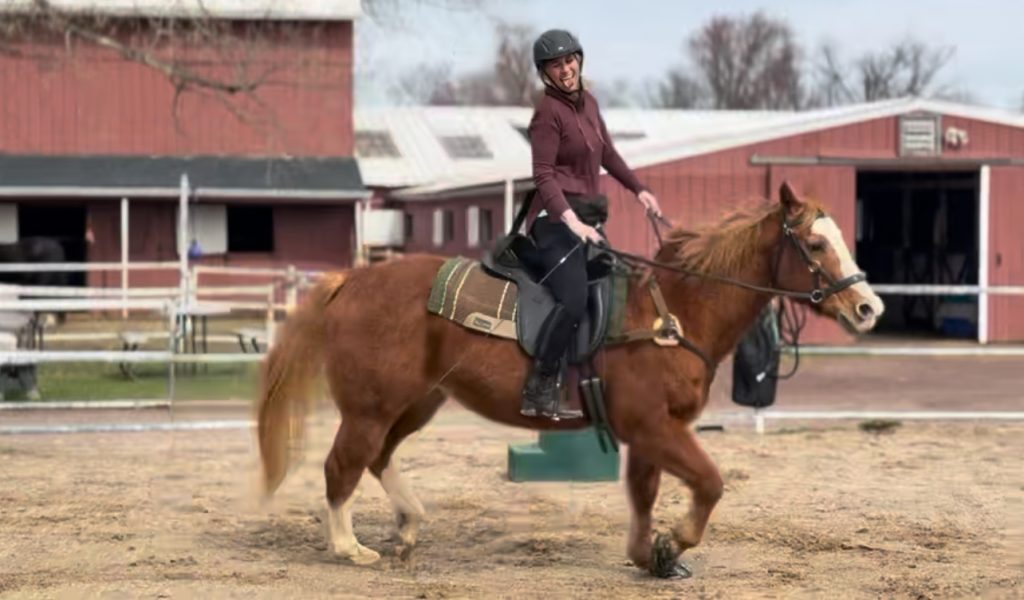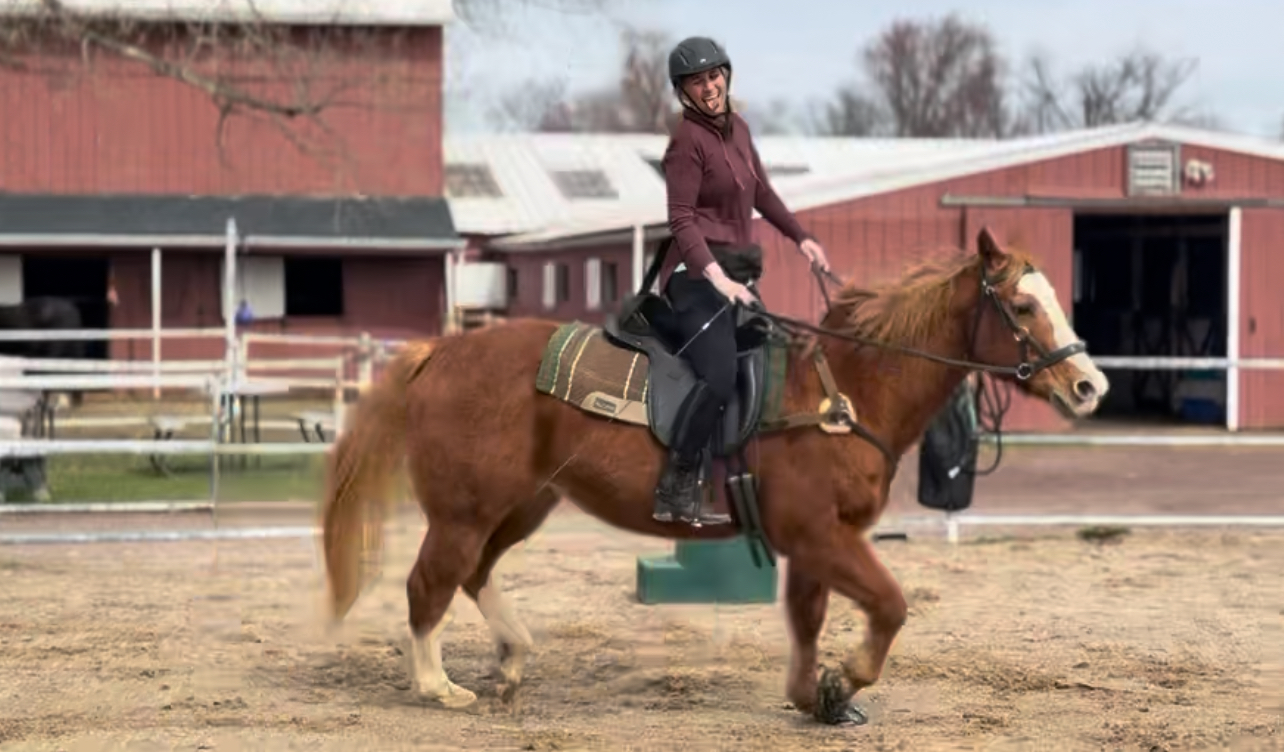It’s winter. The land is hard, the air is cold, the nights are long. A young girl, bereft after the loss of her parents, sits outside of her uncle’s house and stares at the vast plains surrounding her new home. She pulls a scratchy wool blanket tighter around her shoulders, cold but unwilling to go back inside. She only feels like herself when she’s outside under the wide, star-filled sky. Alone.
Or is she?
What is that? A movement from the corner of her eye. She squints against the darkness. A creature, glowing in its brilliance as it picks its way across the scrubby, dead ground. A horse, white and reflecting the glow of the moon. He raises his glorious head, seems to stare right at her. She stares back, afraid to move, afraid to even breathe lest she scare him away. But she doesn’t. How could she? He’s afraid of nothing. He lowers his head, his breath puffing out in hot clouds through his nose. He approaches. She keeps thinking, “Surely now he’ll stop and run off.”
But he doesn’t. He comes closer until his nose is inches from her hands, which lay upturned on her knees. Slowly, he lowers his satiny smooth muzzle into her hands and breathes into her. A bond is formed. Every night, the girl sits under the stars and her stallion comes to her. She needs no words, no tools, no force. He allows her to pet him, to lay her head on his neck, to lie her body on his back, and finally to ride him. They spend their nights galloping through the range, her fingers twined in his mane and her legs wrapped around his middle. With no bridle and no saddle, they communicate with nothing but their thoughts and their souls.
Okay, every horse girl has read a book or watched a movie just like this. Sometimes it’s a horse, or maybe a unicorn, or even a dragon. But our hearts sing at the idea of such freedom, such communication. And whether we admit it or not, this hope lives in our hearts when we think of horses. We want to find our heart horse and build a connection built on choice and soul communication. On pure spirituality and magic.
That hope still lives in my heart.
When I brought my horse, Cowboy, up from Texas to live with me, I had taken a years long break from horses. I went to visit him in his pasture, picked out stones like amethyst and rose quartz and infused them with my energy, and hid them around his field so I would always be with him. When I worked with him on the ground, I hoped we would develop a gentle and easy cadence where I communicated to him with my energy and mind and he responded without hesitation.
That’s not what happened.
Cowboy is a paint horse, but he’s also a quarter horse. (Don’t ask me to explain it, I’m not great at the distinction, but it’s important to some people.) I also believe he was a mule in a past life. He’s incredibly stubborn and excellent at standing still. Like really, REALLY good at standing still. Basically a breathing statue. And while I thought it would be fun to develop a light and easy spiritual connection, he had different ideas. He believed that, actually, playing statue was the most fun thing he could do.
I would put his halter on and attempt to lead him from the pasture and his feet would turn to stone. I’d tug, attempt to turn and back up, bribe with treats, and still we would stand there in the sun, sweating in the 90+ degree heat without him taking a single step. One day it took me over an hour to get him to go a hundred feet. I was stumped. Especially because it didn’t seem to matter where we were going or what we were doing. The day I spent an hour sweating and begging and bribing we were heading BACK to his pasture. Why would he fight that?

I was at a loss.
I was reading and researching as much as I could and working with my mom. She said, “You’re treating him the way you treat your baby, you need to treat him like a teenager. He knows what he’s doing and he’s testing you to see if you’re serious.”
I am serious! How can I be any more serious?
“It’s in your energy. You’re asking him to go. You need to tell him to go. You need to be assertive.”
This was something I had a hard time with. On the one hand, I recognized that Cowboy weighed nearly 10x as much as I did. I can’t make him do anything he doesn’t want to do. I didn’t believe that telling him what to do would work. Also, wouldn’t that ruin our relationship? I wanted to be partners, not his boss forcing him to do things he hated.
We decided to use a whip. A lunge whip, to be exact, that I would carry with me and wave at his rear end if he stopped. It worked, most of the time, but he could still tell that wasn’t always serious. I think the whip helped because it showed him that I was serious, even if I couldn’t always get my energy to tell him that.
I hated it.
He should want to walk with me. We’re supposed to be friends. He hates me and now I have to resort to force to make him spend time with me.
I felt like a failure.
Horses are often a mirror for what we’re feeling or struggling with in other parts of our lives. With horses, however, the stakes are higher than they are in most other situations. It can be life or death. I was struggling with setting boundaries with my son, who was moving from baby to toddler. I didn’t believe I could stop him from doing anything and lived in fear that he would one day dart into traffic or run away so that I couldn’t catch him.
It was same with Cowboy. I would watch my mom halter him and lead him with ease. Why couldn’t I do that? What was it about me that told him he could get away with not listening?

I discovered that I associated assertiveness with aggression. If I were to assert my will on someone, I would be acting aggressively towards them and they would hate me. This felt true for my son as well as my horse.
What is the difference between being assertive and being aggressive? To me, this was an important distinction. Being aggressive means disregarding others needs and desires in order to get what you want. Being assertive means respecting others needs and desires in order to get what you need.
For example, if a horse won’t stand for the farrier, you could handle it aggressively by tying, hobbling, or laying the horse down and forcing them to be trimmed. Or, you could be assertive and say, “You need to have your feet done,” and taking the time to accustom them to standing and having their feet handled. You get the same result with either approach, but being assertive maintains the relationship and trust of your horse and empowers them to handle the situation in the future.
But what you can’t do is what I was doing. Let’s play that out.
Me: Cowboy, you need to go into the field.
Cowboy: No, I want to stand here.
Me: Please?
Cowboy: No thank you, here’s fine.
Me: Okay. *takes off his halter and let’s him win.*
Cowboy, as a horse, doesn’t know the consequences of that decision. He doesn’t know about roads or cars and might walk out onto the street and be seriously hurt. He doesn’t understand that we give him special food and if he were to wander off, he wouldn’t get the nutrition or care that he needs. It’s my job as the human to say, “This is important and we have to do it,”. Humans brought horses into our world. We have to do everything we can to help them function within it and they, like toddlers, do not have the capacity to make well considered decisions in our society.
Now, if I had met Cowboy on the plains and joined his herd, I would default to him in the decision making. He would understand that world of grass and sun and wild animals far better than I would. But, that’s not the case. He was bred to be a human companion. He relies on humans to help him live a safe and happy life. That means I need to be the one to make the decisions and he must learn to follow them.
Being aggressive will damage your horses confidence in you and themselves. It will harm the relationship between you and can cause your horse to become defensive and even aggressive themselves.
Being assertive sets safe and necessary boundaries. It tells your horse, “I’m in charge. You don’t need to worry or try to make decisions. I’ve got it covered.” This will allow your horse to trust you and enable you to develop a more meaningful and even magical connection. Once you assert yourself as your horse’s leader and guide, they will open themselves up to you even more.
When I learned to be assertive with Cowboy, our relationship transformed. We both enjoyed our time together more, we began riding and exploring and even jumping. Anything I ask of him, he does.
And now, we communicate without words. I can get him to back up, turn, and follow me on the ground with no halter and no physical touch or words. I can turn him and speed him up and slow him down without touching the reins. And whenever I get to the barn, I swear, he knows I’m coming even before I send him our special whistle.
We are connected the way I always hoped we would be. But I had to earn his trust and prove myself to him to get there.
It is possible to develop a magical connection with your horse. But it is not instantaneous. It requires time, effort, patience and, of course, being assertive.


No responses yet